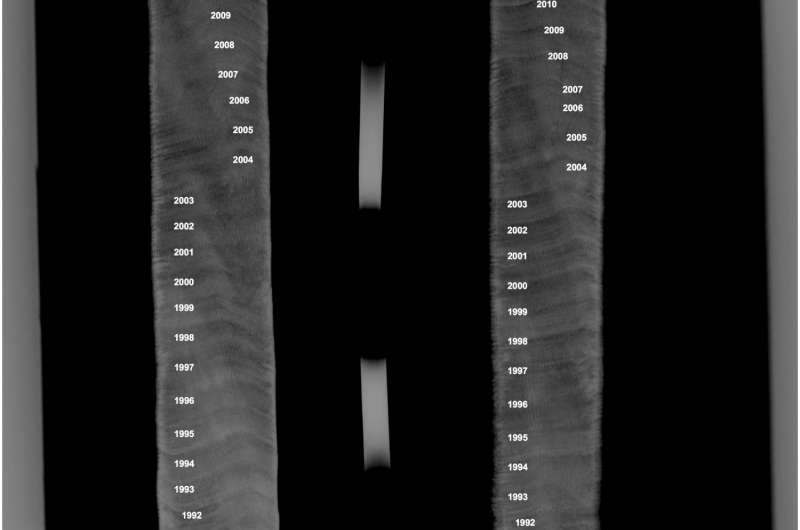Seeing inside coral

Coral reefs sustain marine life all over the world and protect its vulnerable coastlines. But the reefs are increasingly endangered, mainly because of pollution and rising ocean temperatures. Scientists, including American University's Kiho Kim are racing the clock to assess the true extent of the damage before it becomes irreversible. Today, new technologies are making it possible to see inside coral, to examine the skeleton cores for devastation caused by humans.
Kim and his team members are among the first to use a novel chemical technique to study coral skeletons to document the impacts from human activity. A new study published in Marine Pollution Bulletin explains how they did it in the U.S. territory of Guam, a small island nation undergoing dramatic ecological change.
"This study gives us a sense of how big the changes have been over the last 60 years and how population growth is leading to the degradation of the reefs," Kim said.
The researchers worked with coral on the eastern side of the island, in the Togcha River watershed, where a community's sewage plant dumps effluent into the river that then flows downstream to coastal coral reefs. The Togcha reef flat gets polluted from sewage-derived nitrogen from the plant and septic tank outflows. Coral disease is prevalent.
In Guam, as in many island nations, the biggest pollutant is sewage-derived nitrogen, due to poor wastewater infrastructure. Guam's sewage plants are old, effluent is not treated to the highest standards, and water samples routinely show sewage at amounts higher than government levels set for safe recreational waters in freshwater and marine environments.
Figuring out how much sewage-derived nitrogen contributes to coral reef degradation is challenging but important. Researchers must account for other stressors affecting coral, both natural and human-made, like the El Nino weather phenomenon and overfishing. The information scientists glean can help predict what's to come for the reefs of the future.
This is especially critical for Guam, where the island's population, currently 160,000, is set to grow by an estimated 40,000. This influx will occur when U.S. marines and their support services relocate from Japan. Though the marines have not yet moved, the U.S. government is working on plans, according to recent news reports. http://www.guampdn.com/story/news/2017/04/27/military-buildup-presses-while-cautious-historic-properties/100965786/
New technique
Coral reefs are among the most diverse ecosystems of the world's oceans. Communities depend on them for food, for the fish that live in them, and for tourism. They are under stress like never before. Many reefs are taking longer to recover from bleaching events, which occur when warm waters or pollution undermine the coral's ability to feed. Coral turns white and becomes more susceptible to disease. Recently, scientists discovered whole sections of Australia's Great Barrier Reef dead due to warm water temperatures.
When coral grow, they put down layers of skeleton the same way that tree rings grow over time. As waters warm due to climate change, scientists examine these layers to understand temperature changes on coral. Now scientists can study the coral layers for nitrogen pollution by using a new chemical technique, developed by researchers at Princeton, which allows more precise stable isotope analysis of coral skeleton. Kim and his colleagues extracted a single skeleton from a colony of massive coral near the mouth of the Togcha River, in water about six meters deep.
The nitrogen pollution the researchers recorded from the skeleton correlates with Guam's population increases over the last 60 years. Between 1960 and 1980 alone, Guam's population increased tenfold.
The coral skeleton core was extracted by using a 5.5-cm wide, hollow, diamond-tipped drill bit. In this instance, Kim and his team members used a high-pressure air drill attached to a scuba tank to remove a core 70 cm in length. Drilling may sound harsh, but it doesn't hurt the coral.
After extracting the core, which will not be put back, researchers capped the hole with a cement plug. They later observed the coral and found coral tissue growing over the plug, which indicated the coral's health hadn't been harmed.
Confronting coral reef decline
While climate change requires action on a global level, pollution is a local issue that can be addressed better infrastructure and policy, Kim said. Mitigation of nitrogen is critical to conserving the ecosystem of mangroves, seagrasses and corals in Guam's coastal waters.
"Coral reefs on Guam face the simultaneous challenges of multiple—and sometimes conflicting—user needs and impacts from declining water quality. Yet they remain of critical importance to Guam's economy," Kim said. "This situation is common to tropical islands throughout the world. Lessons learned regarding coping with these challenges may provide guidance for other islands in the region."
"Life and death of a sewage treatment plant recorded in a coral skeleton δ15N record," is authored by Nicholas N. Duprey, Xingchen T. Wang, Philip D. Thompson, Jeffrey E. Pleadwell, Laurie J. Raymundo, Kiho Kim, Daniel M. Sigman and David M. Baker.
More information: "Life and death of a sewage treatment plant recorded in a coral skeleton δ15N record,"Marine Pollution Bulletin (2017).
Journal information: Marine Pollution Bulletin
Provided by American University




















